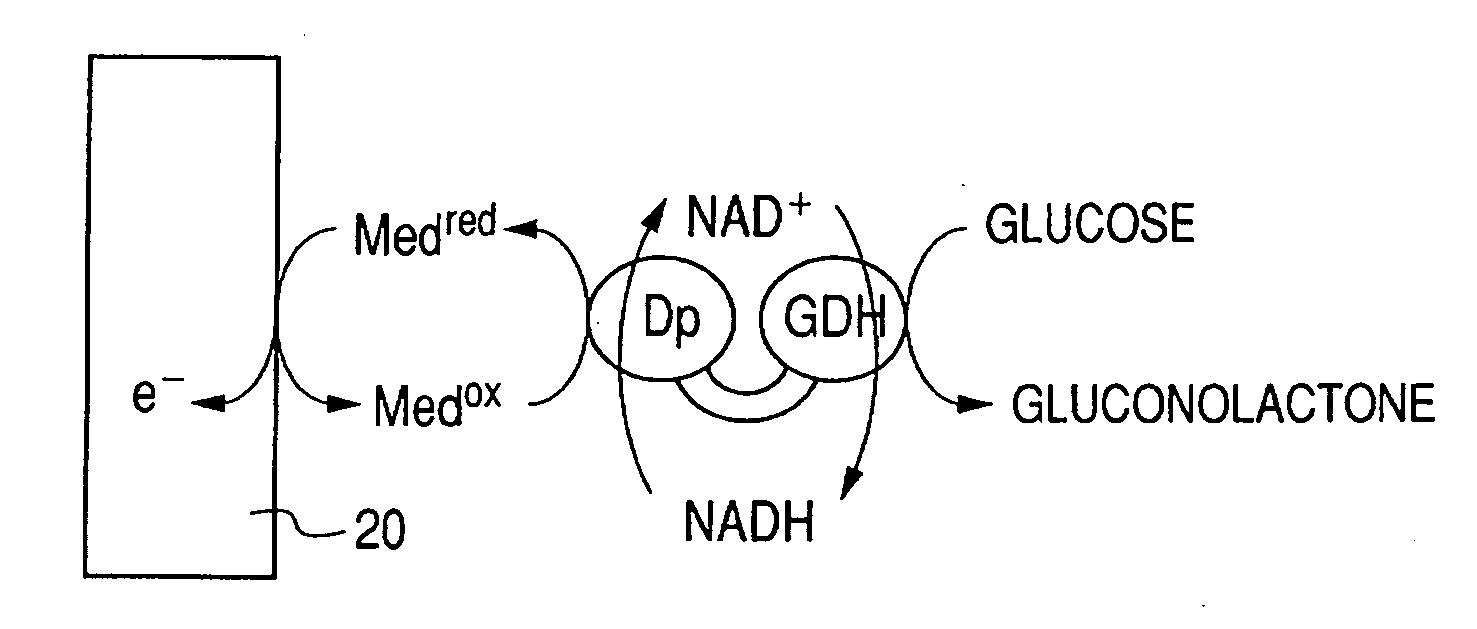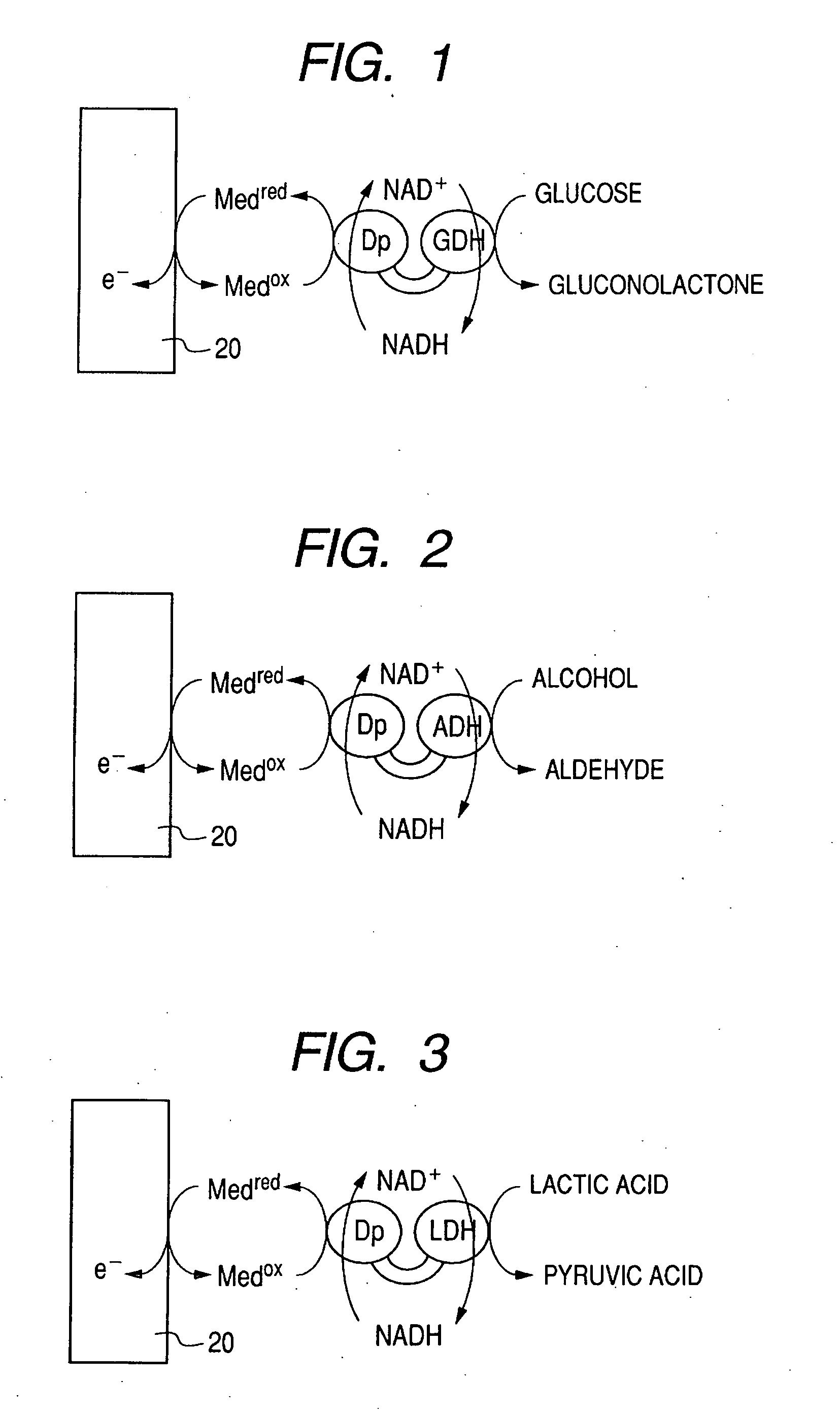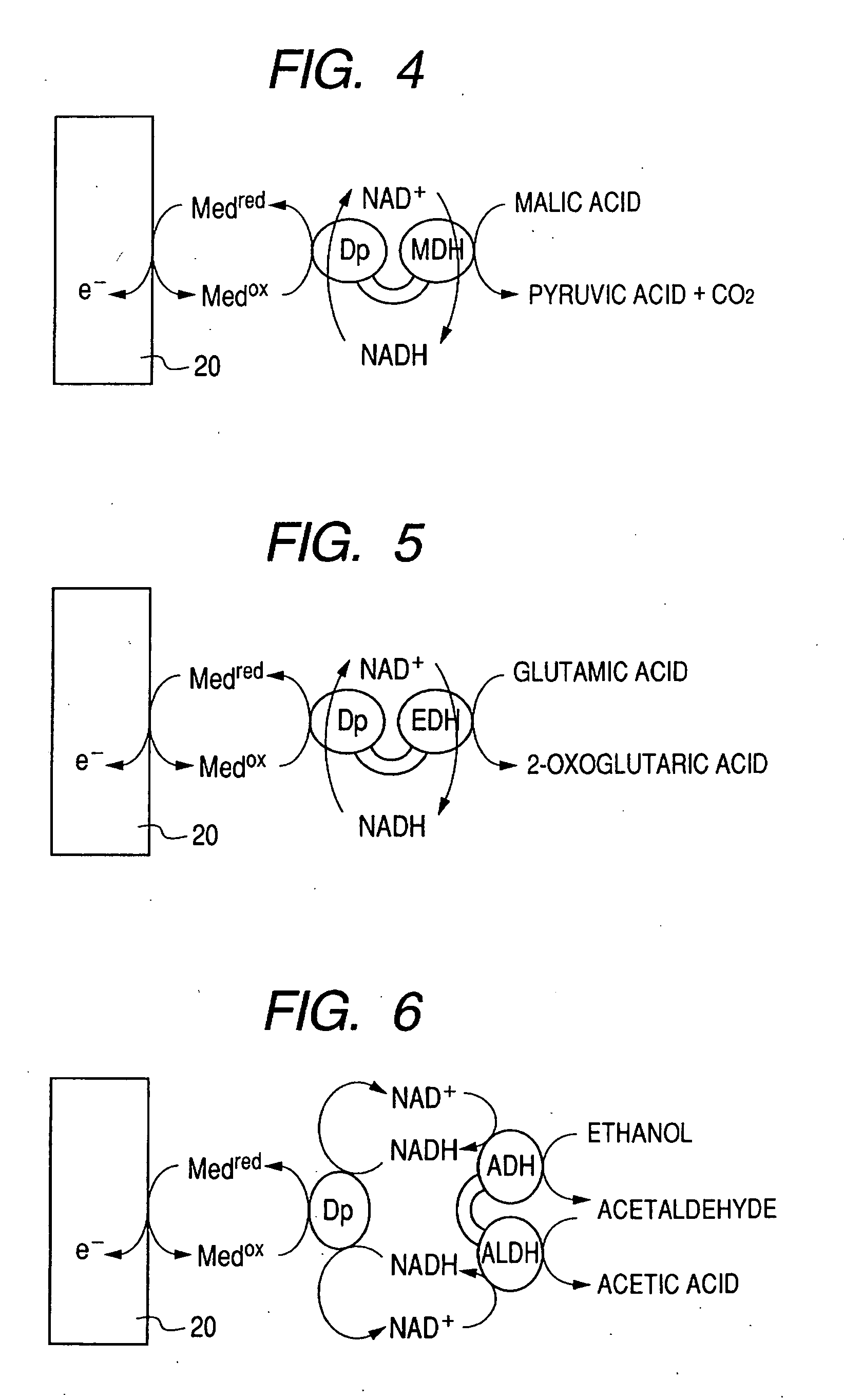Enzyme electrode
a technology of enzyme electrodes and electrodes, applied in the field of enzyme electrodes, can solve the problems of low sensitivity to the reaction substrate 1, fast deterioration of output, and inability to optimize the reaction speed or reaction efficiency of the entire electrode transfer reaction from the reaction substrate 1 to the electrode, etc., to achieve high current value, large current value, and high sensitivity
- Summary
- Abstract
- Description
- Claims
- Application Information
AI Technical Summary
Benefits of technology
Problems solved by technology
Method used
Image
Examples
example 1
Preparation of Fusion Protein (His-busGDH::ppuDp) (SEQ ID NO:10 and 11) of Glucose Dehydrogenase (busGDH) Derived from Bacillus subtilis and Diaphorase (ppuDp) Derived from Pseudomonas putida
[0280] Genomic DNA is prepared from Bacillus subtilis by a normal method. The genomic DNA is used as a mold and following synthetic oligo DNA is used as a primersynthetic oligo DNAs SEQ ID NO:1 having a sequence recognized by BamHI and SEQ ID NO2: having a sequence recognized by HindIII are used as primers for performing PCR, so as to obtain a DNA amplified product of 805 bp.
[0281] The DNA amplified product is cut by restriction enzymes BamHI and HindIII, and inserted in the same restriction enzyme site of pETDuet-1 (manufactured by Novagen) so as to produce a His-busGDH expression vector pETDuet-busGDH.
[0282] Then, genomic DNA is prepared from Pseudomonas putida KT2440 (ATCC 47054) by a normal method. The genomic DNA is used as a mold and following synthetic oligo DNA is used as a primersynt...
example 2
Glucose Sensor
[0300] Example 2 will be explained with reference to FIG. 10 and FIG. 8. The sensor in Example 2 is a glucose sensor for determining the quantity of glucose in a sample solution. The enzyme electrode part of the glucose sensor in Example 2 will be explained with reference to FIG. 10. The enzyme electrode part is constituted as follows.
[0301] A conductive base plate 20 is glassy carbon with diameter of 3 mm. The fusion protein (His-busGDH::ppuDp), and ferrocene-bounded polyallylamine (Fc-PAA) are crosslinked and immobilized on the conductive base plate 20 by poly(ethylene glycol) diglycigyl ether. The fusion protein is the fusion protein of glucose dehydrogenase (busGDH) derived from Bacillus subtilis and diaphorase (ppDp) derived from Pseudomonas putida prepared in Example 1. Hereinafter, poly(ethylene glycol) diglycigyl ether is abbreviated as PEGDE.
[0302] Each of the components is immobilized at following optimal concentrations, respectively. That is to say, the c...
example 3
Glucose Fuel Cell
[0310] Example 3 will be explained with reference to FIG. 10 and FIG. 9. The fuel cell in Example 3 is a glucose fuel cell using glucose as fuel. The anode electrode part of the glucose fuel cell in Example 3 will be explained with reference to FIG. 10. The anode electrode part is constituted as follows.
[0311] A conductive base plate 20 is glassy carbon of 0.5 cm2. The fusion protein (His-busGDH::ppuDp) prepared in Example 5, and ferrocene-bounded polyallylamine (Fc-PAA) are crosslinked and immobilized on the conductive base plate 20 by PEGDE. Each of the components is immobilized at following optimal concentration ratios, respectively. The components are prepared at His-busGDH::ppuDp (busGDH: 0.3 unit and ppuDp: 0.6 unit), Fc-PAA: 16 μg, and PEGDE: 10 μg. The enzyme electrode part is manufactured by mixing each of aqueous solutions of the above-mentioned components on the electrode, leaving to stand in a room temperature for 2 or more hours, and drying them.
[031...
PUM
| Property | Measurement | Unit |
|---|---|---|
| Fraction | aaaaa | aaaaa |
| Electrical conductor | aaaaa | aaaaa |
| Efficiency | aaaaa | aaaaa |
Abstract
Description
Claims
Application Information
 Login to View More
Login to View More - R&D
- Intellectual Property
- Life Sciences
- Materials
- Tech Scout
- Unparalleled Data Quality
- Higher Quality Content
- 60% Fewer Hallucinations
Browse by: Latest US Patents, China's latest patents, Technical Efficacy Thesaurus, Application Domain, Technology Topic, Popular Technical Reports.
© 2025 PatSnap. All rights reserved.Legal|Privacy policy|Modern Slavery Act Transparency Statement|Sitemap|About US| Contact US: help@patsnap.com



